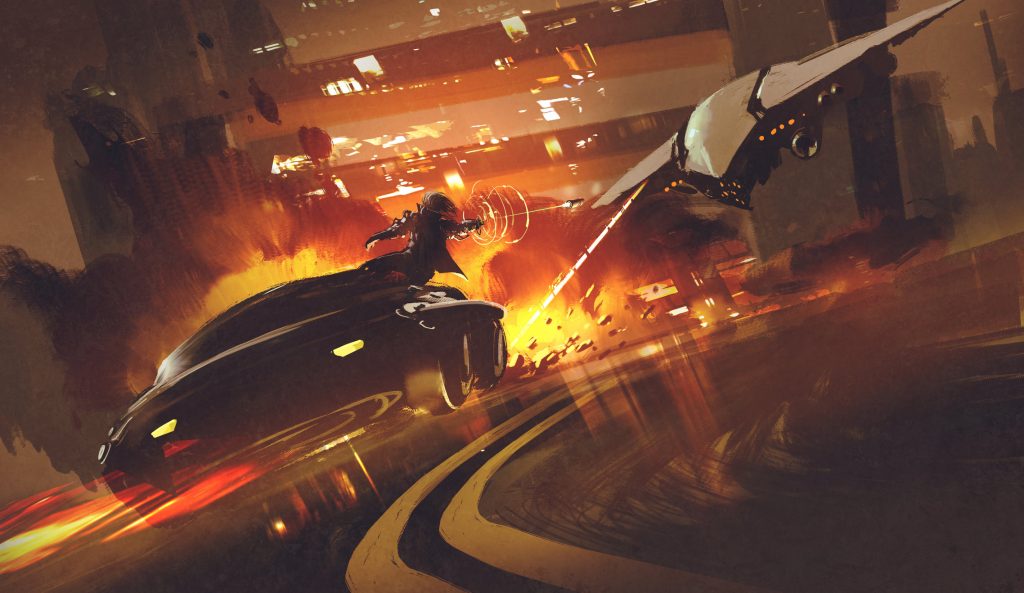Action is a popular film genre that typically features the likes of violence, extended fight scenes, incredible physical feats and mind-blowing car chases. These films tend to focus around a singular hero struggling against the odds, which often include a number of life-threatening situations, in pursuit of the villain.

Whilst action sequences have existed in films for a long time, the genre of action really came into its own in the 1970s along with the increased use of stunts and special effects.
Martial Arts
A well-known sub-genre of action films is the martial arts film. This sub-genre typically involves a lot of hand-to-hand combat between characters, with many of the characters being martial artists. The actors are typically real martial artists, or actors who train fervently for the role, or directors who employ clever camera angles, editing, doubles and computer-generated imagery to create the incredible fight sequences.
Martial arts films are often dominated by the action sequences, with minimal plot and character development so as not remove the focus from the action. One of the earliest Hollywood films to employ the use of martial arts was the 1955 film Bad Day at Black Rock.
During the 70s and 80s, prevalent martial art films were the English-dubbed kung fu and ninja films produced by the Shaw Brothers. The genre has been dominated by Hong Kong action cinema, peaking from 1971 with the rise of actor Bruce Lee until the mid-1990s when the genre began to decline.
Another notable martial arts actor is Jackie Chan, who has starred in numerous Eastern and Western marital arts films, including the action-comedy film series Rush Hour. Whilst the genre has significantly slowed in recent years, it did have an incredibly successful revival in the form of animation with Kung Foo Panada.
Spy Films
Spy films have been around for a long time, the most prominent of which being the James Bond films, which is one of the longest continually running film series in history, having been in production from 1962 to the present day.
Spy films typically deal with the subject of the espionage activities of Government agents and the risk of being discovered by enemies. From the Nazi espionage thrillers of the 1940s to James Bond and to the high-tech blockbusters of today, spy films have always been incredibly popular with audiences.
Spy films began in the silent era with the paranoia of invasion literature and the onset of World War I. In 1928, the film Spies contained many tropes that became popular in later spy dramas, including a secret headquarters only known to a few and a beautiful foreign agent who falls for the hero. Alfred Hitchcock popularised spy films in the 1930s with his influential thrillers The Man Who Knew Too Much, The 39 Steps and The Lady Vanishes.
Their popularity peaked in the 1960s when Cold War fears meshed with the audiences’ desire to see suspenseful films. Realistic spy novels were adapted into serious Cold War thrillers, and then the fantastical, tongue-in-cheek adventures of James Bond followed. Spy films had a bit of a revival in the 90s with the spy-comedy Austin Powers. But the trend for spy films today is a focus on realism, as seen in the likes of Casino Royale, Quantum of Solace and Skyfall.
Buddy Cops
Buddy cop films are a sub-genre of action films that involve two people with conflicting personalities who are forced to work together to solve a crime or defeat a common enemy, often learning a lot about each other in the process. Buddy cops are typically police officers or secret agents, and these films are often also comedies or thrillers.
A common trope of the buddy cop dynamic is that one character is the ‘wilder’ of the two, more liable to rule-breaking and being hot-tempered. Their counterpart is the more even-tempered one, often older with more patience and experience. It often falls into the ‘good cop/bad cop’ motif, with one partner being law-abiding and the other more ‘street-wise’. Another frequent plot device is placing one in an unfamiliar setting, such as requiring field work of a non-cop, a newbie or an office-bound ‘desk jockey’.
Early pioneers of this genre are Heat of the Night (1967) and Freebie and the Bean (1974). It was popularised in the 1982 film 48 Hrs., one of the most successful buddy cop films. Rush Hour is also an example of the buddy cop dynamic, along with the recent animated film Zootopia.
